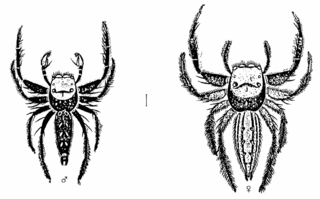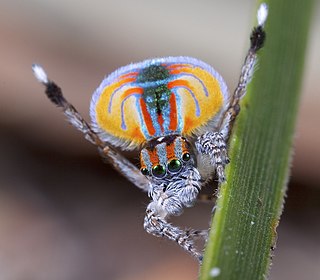
Austracantha is a genus of spider with a single species, Austracantha minax, commonly known as the jewel spider or the Christmas spider. It is a member of the family Araneidae and is endemic to Australia. They are relatively small spiders, reaching a maximum total body length of only around 12 mm (0.47 in) for females, and 5 mm (0.20 in) for males. Their abdomen has six distinctive projections ("spines") that makes them easy to identify. They are predominantly a shiny black, with variable white, yellow, and orange patterns. Melanistic forms also occur during autumn. They are facultatively gregarious, and can be found in large aggregations of overlapping orb webs. They feed on small flying insects that get entangled in their webs. They are harmless to humans, though the webs can be a nuisance for bushwalkers. They are most abundant during the summer months.

Bavia is a genus of jumping spiders.

Clynotis is a genus of spiders in the family Salticidae, or jumping spiders, contained within the subfamily Marpissinae. They are found across Australia and New Zealand, with some species occupying the Auckland Islands and one found exclusively on Snares Island. There are eight species currently described within the genus, the earliest noted being the type species Clynotis severus, first described in Queensland, New South Wales, Australia in 1879 by Ludwig Carl Christian Koch. The most recent was described in 1931 by Lucien Berland. Two other species previously held within the genus were subsequently reclassified into the genus Tara.

Maratus is a spider genus of the family Salticidae. These spiders are commonly referred to as peacock spiders due to the males' colorful and usually iridescent patterns on the upper surface of the abdomen often enhanced with lateral flaps or bristles, which they display during courtship. Females lack these bright colors, being cryptic in appearance. In at least one species, Maratus vespertilio, the expansion of the flaps also occurs during ritualised contests between males. The male display and courtship dance are complex, involving visual and vibratory signals.

Margaromma is a spider genus of the jumping spider family, Salticidae. The eight described species occur mostly in Australia and New Zealand, with several other species on Pacific islands. One species is found in Cameroon.

Piranthus is a genus of jumping spiders first described in 1895 by Tamerlan Thorell, who derived the name from Greek mythology. As of February 2019 this genus contains only two species.

Prostheclina is a genus of Australian jumping spiders that was first described by Eugen von Keyserling in 1882.
Pseudamycus is a spider enus of the jumping spider family, Salticidae. The monotypic genus Taivala is thought to be closely related.
Lophostica mauriciana is a species of spider in the family Salticidae. It is found only in the islands of Mauritius and Réunion in the western Indian Ocean.

Euophryini is a tribe of jumping spiders. It has also been treated as the subfamily Euophryinae.

Sidymella rubrosignata is a species of crab spiders found in Australia. It is a common spider, often seen on Dianella plants.

Zygoballus sexpunctatus is a species of jumping spider which occurs in the southeastern United States where it can be found in a variety of grassy habitats. Adult spiders measure between 3 and 4.5 mm in length. The cephalothorax and abdomen are bronze to black in color, with reddish brown or yellowish legs. The male has distinctive enlarged chelicerae and front femora. Like many jumping spiders, Z. sexpunctatus males exhibit ritualized courtship and agonistic behavior.
Tegenaria abchasica is a spider species found in Russia and Georgia.

Metaltella simoni is a species of spider, native to South America, and introduced into the United States and Canada.
Ansienulina mirabilis is a species of jumping spiders. It is the only species in the genus Ansienulina.
Chrysilla guineensis is a species of jumping spider. It is endemic to Guinea. It was described in 2013 based on specimens collected from the Nimba Mountains.
Cytaea taveuniensis is a jumping spider species in the genus Cytaea. The male was first identified in 2010 by Barbara Maria Patoleta and Joanna Gardzińska. The female has not been described.
Diminutella is a genus of spiders in the family Sparassidae. It was first described in 2018 by Rheims and Alayón. It is a monotypic genus with one described species, Diminutella cortina. It is endemic to Pinar del Rio, Cuba.
Exechocentrus lancearius is a species of spider in the orb-weaver spider family Araneidae, found only in Madagascar. It was initially described from a partial specimen of an adult female. The first description of a complete specimen and its prey-catching behaviour was published in 2012. E. lancearius is a bolas spider. Rather than using a web, adult females catch their prey by using a line with one or two sticky drops which they swing.
Ordgarius monstrosus is a species of spider in the orb-weaver spider family Araneidae, found in Queensland, Australia. O. monstrosus is a bolas spider. Rather than using a web, adult females catch their prey by using a line with one or two sticky drops which they swing.











